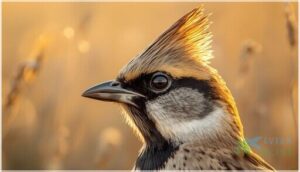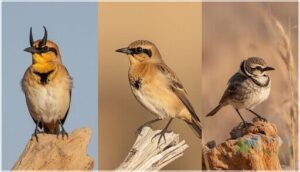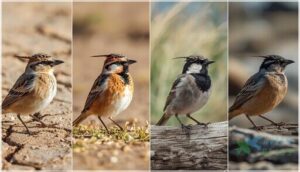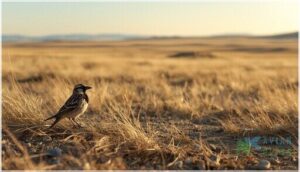This site is supported by our readers. We may earn a commission, at no cost to you, if you purchase through links.
You might walk right past a Horned Lark without noticing it—until the bird launches skyward, singing its tinkling song hundreds of feet above the open ground. This ground-dwelling species has mastered the art of disappearing into its surroundings, its plumage matching local soil tones so precisely that researchers sometimes struggle to spot nests just meters away.
Yet despite this striking camouflage, Horned Larks face a grim reality: their populations have crashed by 64% since 1966, making them one of North America’s fastest-declining grassland birds. Understanding what makes these birds tick—from their bold black facial markings to their preference for wide-open spaces—becomes essential as conservationists race to preserve the dwindling habitats these larks need to survive.
Table Of Contents
- Key Takeaways
- Horned Lark Identification and Features
- Preferred Habitats of Horned Larks
- Range and Migration Patterns
- Behavior, Diet, and Vocalizations
- Breeding, Nesting, and Conservation
- Frequently Asked Questions (FAQs)
- Where do Horned Larks live?
- Is a horned lark a sparrow?
- What is the difference between horned lark and meadowlark?
- Do Horned Larks sing?
- How do Horned Larks interact with humans?
- What are common predators of Horned Larks?
- Do Horned Larks have unique behaviors in winter?
- How do Horned Larks cope with climate change?
- Are Horned Larks kept as pets anywhere?
- What predators hunt horned larks in the wild?
- Conclusion
Key Takeaways
- Horned Larks have experienced a catastrophic 64% population decline since 1966, making them one of North America’s fastest-declining grassland birds, with the Pacific Northwest’s streaked subspecies now federally threatened at fewer than 1,600 individuals.
- These ground-dwelling specialists require expansive treeless landscapes of at least 300 acres with bare ground and short vegetation, where their soil-matching camouflage makes them nearly invisible yet renders them vulnerable to habitat loss from agricultural conversion and development.
- The species exhibits remarkable adaptability across 42 worldwide subspecies spanning diverse environments from Arctic tundra to desert floors, with some populations migrating over 3,000 kilometers while others remain year-round residents.
- Conservation efforts face compounding challenges from habitat fragmentation, invasive plant species, climate-driven metabolic stress (increasing energy demands by 43% winter-to-summer), and nest predation rates exceeding 50% at many sites, though targeted grassland restoration shows promise for recovery.
Horned Lark Identification and Features
When you’re scanning an open field or prairie, knowing what to look for makes all the difference in spotting a Horned Lark. These small songbirds have a distinctive look that sets them apart from other ground-dwelling species you might encounter.
Let’s break down the key features that’ll help you identify them with confidence.
Distinctive Black Chest and Ear Marks
When identifying a Horned Lark, you’ll notice the striking black mask and thick chest band that define this species. Males sport bold black markings used for sexual signaling, while females display duller brown bands. These features aid in subspecies ID and may serve camouflage functions or even glare reduction in open habitats.
Juveniles lack clear chest bands, showing streaked patterns instead—a key identification detail. As a ground-dwelling bird, the horned lark is a permanent resident in open areas.
Tiny Black Horns and Facial Patterns
Beyond the chest markings, you’ll see those namesake “horns”—tiny black feather tufts (5-15 mm tall) that males raise during breeding season. These structures play a key role in sexual selection and territorial displays. The black mask stretches from beak through eye, creating sharp contrast against yellow or white facial patches that vary by subspecies. They thrive in areas of open ground, such as prairies and fields.
- Horn size correlates with male reproductive success
- Facial camouflage breaks up the bird’s outline against bare ground
- Pattern dimensions shift across geographic populations, reflecting habitat-specific adaptations
Male, Female, and Juvenile Differences
When you compare male and female horned larks, plumage variation and size dimorphism become clear. Male horned larks carry bold black masks and breast bands, while female horned larks show paler tan faces with softer brown markings. Juvenile horned larks lack these patterns entirely, displaying mottled brown backs with white-edged feathers.
Males average 32 grams—slightly heavier than females at 30.6 grams—though parental roles remain balanced during nesting.
Size and Comparison to Other Birds
Horned larks measure 6.3 to 7.9 inches in length, with wingspans stretching 11.8 to 13.4 inches—making them larger than Savannah Sparrows but smaller than Eastern Meadowlarks. Their lightweight frames, weighing just 1.0 to 1.7 ounces, support agile ground movement across open habitats.
Their compact build reflects adaptations to treeless landscapes, where short conical bills aid seed collection and rounded heads accentuate their distinctive silhouette during identification.
Subspecies Variations and Island Forms
Forty-two subspecies worldwide showcase considerable morphological variation, from pale desert forms to darker coastal birds. Subspecies identification relies on coloration, size, and wing length, with some populations facing elevated conservation status concerns due to restricted ranges and habitat loss.
You’ll notice island endemism on California’s Channel Islands, where Eremophila alpestris insularis displays a longer broader bill and darker plumage—genetic divergence shaped by isolation.
Preferred Habitats of Horned Larks
If you want to find a Horned Lark, you won’t be searching through forests or dense shrublands. These birds are specialists of wide-open spaces, where visibility stretches to the horizon and vegetation stays low to the ground.
Understanding where they thrive will help you know exactly which landscapes to scan when you’re out in the field.
Open Ground and Treeless Environments
If you’re scanning a wide-open horizon with no trees breaking the skyline, you’ve found prime Horned Lark habitat. These birds need expansive treeless landscapes—ideally 300 acres or more—with plenty of bare ground and vegetation structure kept low by disturbance regimes like fire or grazing.
Habitat fragmentation and human modification pose serious threats, making conservation efforts focused on maintaining these open field habitats increasingly critical for their survival.
Prairies, Fields, and Tundra Habitats
Across North America’s short-grass and mixed-grass prairies, you’ll encounter Horned Larks at their highest densities—often exceeding 15 pairs per 100 hectares in favorable conditions. These open field habitats extend into agricultural impact zones like plowed fields and stubble, though habitat loss has driven steep declines.
In tundra occupancy zones above the tree line, they favor dry, shrub-free expanses during breeding season.
Adaptations to Bare Ground and Short Vegetation
You’ll notice that horned larks thrive where other grassland species won’t—bare ground is their sweet spot. Their plumage camouflage matches local soil tones, cutting predator detection by nearly half.
Foraging behavior centers on open fields, where walking and running dominate their feeding behavior. Physiological traits like solar-reflective feathers reduce water loss by 17% in arid habitats.
Nest site selection favors exposed ground, boosting population density where vegetation stays sparse—critical for nesting success and conservation.
Seasonal Habitat Shifts
You’ll find that horned larks shift habitats as seasons change, with migration carrying some populations over 1,000 kilometers from breeding to wintering grounds. Habitat fidelity exceeds 75% annually, yet agricultural impacts and climate effects drive adaptive management needs.
Winter distributions favor:
- Fields averaging 17% bare ground
- Open airstrips and refuges
- Agricultural lands with sparse vegetation
- Treeless expanses across their geographic distribution
These seasonal movements reflect both range-wide migration patterns and local habitat changes throughout their winter territories.
Range and Migration Patterns
Horned Larks have one of the most impressive ranges among North American songbirds, stretching across entire continents and adapting to everything from Arctic tundra to desert floors.
You’ll find them in vastly different locations depending on the season, with some populations staying put year-round while others migrate thousands of miles. Understanding where these birds live and how they move throughout the year gives you a fuller picture of their striking adaptability.
North American Distribution
The Horned Lark’s breeding range stretches from Arctic Canada to central Mexico, covering most of the United States and southern Canada. Twenty-one subspecies inhabit North America, though distribution changes show concerning declines—especially in eastern regions where habitat loss drives steady geographic contraction.
You’ll find the highest population density in the Great Plains and western states, where over 100 birds per survey route occur.
Global Range Across The Northern Hemisphere
Beyond North America, the Horned Lark range spans the entire Northern Hemisphere in a Holarctic distribution pattern. Over 40 subspecies occupy Eurasia, northern Africa, and isolated Colombian Andes populations—reflecting striking subspecies diversity across treeless landscapes:
- European Alps and Scandinavian tundra breeding zones
- Russian steppes extending to Japan
- North African desert edges in Morocco and Algeria
- Arctic coastlines circling the polar region
Range fragmentation threatens peripheral populations, while core habitat occupancy remains stable. Population estimates suggest millions globally, though habitat loss increasingly constrains the geographic distribution of birds in southern zones.
Migratory Vs. Resident Populations
Within that expansive range, you’ll encounter two distinct life strategies: migratory populations breed from northern Alaska to southern Canada, traveling migration distances exceeding 3,000 kilometers, while resident populations occupy southern territories year-round.
This behavioral split drives genetic diversity patterns—residents like streaked horned larks show remarkably low variability due to philopatry and isolation. Migration patterns directly influence breeding time, habitat exploitation strategies, and the alarming population decline affecting migrants more severely each winter season.
Seasonal Movements and Wintering Areas
Migration patterns shift dramatically as October arrives—northern breeders depart for southern wintering areas by late November, with some traveling to the Gulf of Mexico.
You’ll find 72% of streaked horned larks concentrated in the Willamette Valley’s agricultural fields during the winter season, where flocks exploit bare ground and waste grain.
Site fidelity remains low; winter visitants move between regions, tracking suitable foraging conditions year to year.
Behavior, Diet, and Vocalizations
Watching a Horned Lark in the field reveals behaviors finely tuned to life in open, exposed habitats. These birds spend nearly all their time on the ground, where they forage with purpose and communicate through distinctive vocalizations.
Understanding how they feed, what they eat through the seasons, and how they interact with one another gives you a fuller picture of their daily lives.
Ground Foraging and Feeding Habits
You’ll spot these birds walking—never hopping—across bare ground, searching for food with steady determination. Foraging behavior centers on areas with gravel and sparse vegetation, where prey selection becomes easier.
Territory size averages 0.3 to 1.7 hectares, varying with habitat management practices.
Their diet composition includes seeds and insects, with winter foraging focused primarily on seeds as availability shifts seasonally.
Seasonal Diet Changes: Seeds and Insects
Throughout the year, you’ll notice the horned lark diet shifts dramatically with temperature and food availability. Summer insect protein makes up roughly 50% of their intake—grasshoppers, beetles, and caterpillars fuel breeding adults and growing chicks.
Winter seed reliance dominates as metabolic rate impact drives energy needs up 26%, pushing these birds toward grass and forb seeds in agricultural food sources and natural habitat food interaction zones.
Song Characteristics and Call Types
You’ll recognize horned lark songs as high-pitched, tinkling notes averaging 5,500–8,000 Hz, often delivered during impressive aerial courtship displays. Their vocal repertoire includes 6–12 distinct vocalizations with regional dialects evident across populations.
Call functions vary: brief contact calls maintain flock cohesion, sharp alarm calls warn of danger, and specialized invitation calls accompany breeding flights.
Song divergence among subspecies reveals fascinating call pattern differences, with northern birds producing longer, more complex sequences during spring breeding periods.
Social Behavior and Flocking
During non-breeding seasons, you’ll find horned larks forming flocks of 50–500 individuals, often joining mixed flocks with snow buntings and Lapland longspurs. This flocking behavior provides important foraging benefits through shared flock vigilance, reducing individual alert time by 37%.
In contrast, the breeding season triggers intense territory defense, with males guarding 1.6–3.5 hectare territories.
Social hierarchy within winter flocks places experienced birds centrally, while subordinates occupy outer perimeters.
Breeding, Nesting, and Conservation
Horned Larks get an early start on the breeding season, often nesting while snow still lingers on the ground. Their courtship includes striking aerial displays, and the female takes charge of building a simple ground nest that’s both exposed and surprisingly well-hidden.
Understanding their nesting habits also sheds light on the conservation challenges this widespread species now faces across its range.
Nest Construction and Placement
Female Horned Larks exhibit considerable site fidelity, often returning to their natal areas to nest. They excavate shallow ground depressions lined with fine grasses, rootlets, and soft materials like feathers or fur—a weaving process taking four to six days.
Nest placement maximizes camouflage and microclimate protection, generally positioned on bare ground north of vegetation clumps to reduce wind exposure. Renesting occurs if initial attempts fail, with materials carefully selected for concealment.
Egg Incubation and Parental Care
Once incubation begins, you’ll find the female dedicating 11 to 13 days to warming her clutch size of 3 to 5 eggs. Egg incubation demands intense commitment, with these key parental roles unfolding:
- Female broods eggs over 90% of daylight hours
- Both parents feed altricial young insects 8–18 times hourly
- Nestling feeding continues 8–12 days post-hatch
- Males provide under 40% of provisioning trips
- Habitat impact drives nest success below 40% in fragmented areas
This avian parental care strategy ensures rapid nestling development.
Breeding Displays and Courtship
You’ll witness male Horned Larks performing impressive courtship flights, soaring 500–800 feet before plummeting while delivering tinkling flightsong displays. These aerial displays, repeated up to 12 times hourly during peak breeding, establish territory defense across 1.6–3.5 hectares.
Ground rituals follow—males strut with erect horns, while sexual selection favors larger males.
On breeding grounds, nest success varies dramatically, from 23% to 100% depending on habitat quality.
Population Trends and Conservation Challenges
Despite those stunning aerial courtship displays, Horned Larks face serious threats. You’re looking at a 64% population decline between 1966 and 2019—that’s nearly 2% dropping off each year. The Pacific Northwest’s streaked subspecies hangs on with fewer than 1,600 individuals, earning federal threatened status.
Horned Larks have declined 64% since 1966, with the Pacific Northwest’s streaked subspecies now federally threatened at fewer than 1,600 birds
Major conservation challenges include:
- Habitat loss from agricultural development and urbanization
- Fragmented populations with remarkably low genetic diversity
- Invasive plant species crowding out native grasslands
- Reduced natural disturbances like flooding and fire
- Predation pressure and disease in isolated groups
Climate impacts compound these threats, though restoration efforts show promise.
Effects of Habitat Loss and Climate Change
Habitat loss and climate change impacts converge to accelerate population decline. Nearly 90% of Willamette Valley floodplain grassland has vanished to agriculture, while habitat fragmentation isolates breeding groups.
Temperature shifts increase metabolic demands by 43% winter-to-summer, and extreme weather events destroy nests during critical periods.
Agricultural impact from early mowing coincides with peak nesting, compounding nest survival challenges across fragmented landscapes.
Frequently Asked Questions (FAQs)
Where do Horned Larks live?
You’ll find these grassland species thriving in open habitats and treeless landscapes, from sea-level prairies to alpine tundra at 4,000 meters.
Their habitat selection favors bare ground, short vegetation, and wide-open areas across remarkable elevation ranges.
Is a horned lark a sparrow?
It’s one of the biggest mix-ups in bird identification—sparrows and horned larks aren’t related at all.
They belong to completely different taxonomic families, with distinct genetic divergence, morphological differences, behavioral traits, and naming conventions separating these bird species by their unique physical characteristics.
What is the difference between horned lark and meadowlark?
Though meadowlarks wear bold yellow breasts with black V-markings and belong to the blackbird family, horned larks sport subtle sandy-brown plumage with distinctive black facial horns and represent North America’s only true lark species.
Do Horned Larks sing?
Yes, you’ll hear Horned Larks sing—but only males vocalize. Their acoustic display includes high-pitched, tinkling flight songs for territory defense and mate attraction, with singing seasonality peaking during breeding from January through July.
How do Horned Larks interact with humans?
You’ll encounter Horned Larks in agricultural fields and airports, where they cause crop damage yet benefit from habitat alteration.
Conservation efforts address human-induced threats like pesticides and wind turbines while fostering positive interactions through protective management.
What are common predators of Horned Larks?
You’ll spot avian predators like Northern Harriers and Red-tailed Hawks hunting adult larks, while mammalian predators—raccoons, skunks, and domestic cats—devastate nests.
Nest predation accounts for up to 90% of breeding failures in vulnerable habitats.
Do Horned Larks have unique behaviors in winter?
During winter, you’ll find Horned Larks forming large nomadic flocks across open fields, shifting their diet from insects to seeds while demonstrating considerable thermoregulation.
Migration patterns vary regionally, with snow foraging behavior observed in late afternoons.
How do Horned Larks cope with climate change?
Like canaries in coal mines, avian species decline signals broader climate threats. Horned Larks adapt through metabolic adjustments and elevational shifts, but reproductive impacts from extreme weather, coupled with habitat threats, challenge their conservation status despite behavioral responses to effects of climate change on birds.
Are Horned Larks kept as pets anywhere?
No, you won’t find Horned Larks in the pet trade anywhere. Legal protections under the Migratory Bird Treaty Act, ethical concerns, captivity challenges, and their conservation status make private ownership prohibited and impractical.
What predators hunt horned larks in the wild?
Predators stalk these ground-nesting birds relentlessly—raccoons, skunks, corvids, and hawks lead the charge.
Nest predation rates exceed 50% at many sites, while juvenile survival rates hover around just 16%, severely limiting population recovery across their range.
Conclusion
The irony cuts deep: a bird that perfected the art of invisibility now desperately needs us to see it. Your ability to recognize a Horned Lark—those diagnostic black horns, chest patches, and preference for stark open ground—matters more than ever as populations plummet.
These ground-hugging specialists won’t survive on camouflage alone. They need intact grasslands, reduced agricultural disturbance, and observers willing to notice what’s disappearing. Sometimes the hardest species to spot are the ones we can least afford to lose.













